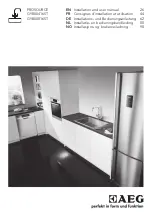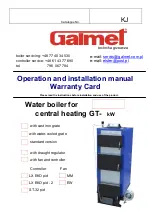
12 Installing the Boiler
2.1 Choosing an Installation
Location
When choosing an installation location, you
must ensure that the location provides adequate
clearance for the boiler, adequate venting and
drainage options, and sufficient access to gas,
water, and electrical supplies. Carefully consider
the following factors when choosing an installation
location:
WARNING
●
Do not install outdoors. Outdoor installation
may result in property damage, severe
personal injury, or death. Damage to the
boiler resulting from installation outdoors is
not covered by warranty.
●
Do not install this boiler in a recreational
vehicle, trailer, boat or other moving vehicles
as it will result in a Carbon Monoxide
Poisoning Hazard.
Note
If the boiler is installed in Massachusetts,
refer to “Requirements for the State of
Compliance Requirements
●
Local, state, provincial, and national codes, laws,
regulations, and ordinances.
●
National Fuel Gas Code, ANSI Z223.1-latest
edition.
●
Standard for Controls and Safety Devices for
Automatically Fired Boilers, ANSI/ASME CSD-1,
when required.
●
National Electrical Code.
●
For Canada only: B149.1 Installation Code,
CSA C22.1 Canadian Electrical Code Part 1,
CSA-B214-12 Installation code for hydronic
heating systems, and any local codes.
Access to Utilities
●
Water – the installation location should be near
where the domestic water supply enters the
building.
●
Gas – the installation location should be near
where the gas supply enters the building.
●
Electricity – the installation location should
be near where the electrical supply enters the
building.
Humidity and Contact with Water
When installing the boiler, avoid places with
excessive humidity. The boiler has electric gas
ignition components. Moisture can get inside
the boiler and damage the ignition system. The
boiler must be installed in a way to ensure that
the gas ignition system components are protected
from water (dripping, spraying, rain, etc.) during
operation and service.
Adequate Drainage
The boiler produces a significant amount of
condensate during operation. The boiler should be
located near a suitable drain and where damage
from a possible leak will be minimal. Installing the
boiler in a location without a drain will void the
warranty and Navien will not be responsible for
water damages that occur as a result. For more
information about condensate drainage, refer to “3.2
Connecting the Condensate Drain” on page 23.
The boiler must be located in an area where leakage
of the unit or connections will not result in damage
to the area adjacent to the appliance or to lower
floors of the structure. When such locations cannot
be found, installation of an adequately drained drain
pan under the boiler is highly recommended. When
installing the drain pan, ensure that the installation
does not restrict combustion air flow.
2. Installing the Boiler













































